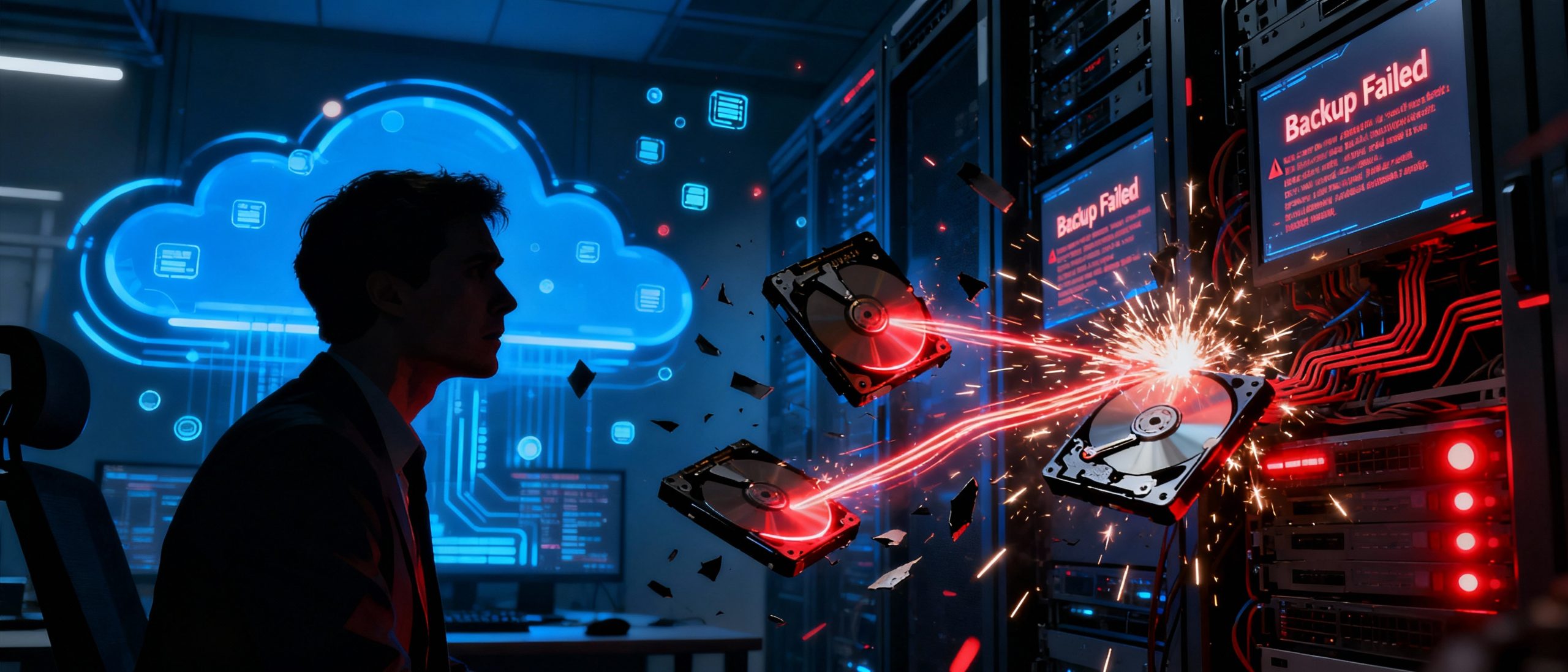When most small and mid-sized businesses think about protecting their data, the first instinct is simple: “We have backups, we’re safe.”
Unfortunately, that belief has led thousands of SMBs into costly downtime, data loss, and complete operational shutdowns. In today’s threat landscape, true business resilience requires far more than storing copies of your data.
It requires a strategy, a real disaster recovery plan designed to keep your business running even when the unexpected happens.
The Hard Truth: Why Disaster Recovery Has Become a Business Essential
Small and mid-size businesses face the same digital threats as large enterprises, but without the staff, budget, or infrastructure to absorb the damage. A single outage can shut down payroll, halt order processing, stall client communication, and interrupt every core workflow that keeps the business running.
Disaster recovery is what ensures that even when the unexpected happens, a cyberattack, a system crash, a failed server, your business stays operational with minimal disruption.
And the numbers paint a very clear picture:
- 58% of backups fail during restoration
- 40% of SMBs have no idea whether their backups actually work
- 70% never test their backups
- 1 in 3 businesses experience backup corruption
These statistics show one thing: most small businesses are far less protected than they think.
Backups vs. Disaster Recovery: A Critical Distinction SMBs Often Miss
Backups serve one purpose, saving copies of data. Disaster recovery exists for a very different reason, bringing entire systems back online quickly and efficiently.
Backups don’t rebuild servers, restore applications, or provide failover environments. They don’t minimize downtime or protect against ransomware. They simply store information.
Disaster recovery, on the other hand, ensures:
- Your systems remain available
- Applications can be restored rapidly
- Downtime is minimized
- Business operations continue, even during disruptions
This is why many SMBs are caught off guard during an outage. They believe backups and disaster recovery are interchangeable, but in reality, they are complementary tools that solve completely different problems.
A true disaster recovery solution typically includes virtualized recovery environments, automated testing, cloud failover, immutable backup copies, and clearly defined recovery objectives, not just data storage.
The Most Common Reasons SMBs Experience Backup Failure
Backup failures rarely happen “out of nowhere.” They’re usually the result of corrupted files, outdated configurations, broken retention policies, hardware issues, or simple human error.
Even cloud backups fail when they aren’t tested or properly monitored. Misconfigured sync settings, expired authentication, overwritten snapshots, and silent cloud-storage errors are more common than most businesses realize.
The worst part? Most SMBs don’t discover these issues until the moment they need their backups, when it’s already too late.
If you discover a failure, immediate action is crucial. Stop using the affected system, identify your last known good restore point, check any secondary backup sources, and notify your IT provider right away. Quick response often determines whether data is recoverable.

Building a Disaster Recovery Plan That Actually Works
A reliable SMB disaster recovery plan goes far beyond storing copies of data. It’s a structured, tested, and continuously validated strategy that ensures a business can recover quickly and consistently from any disruption.
A strong plan includes clear RTO and RPO targets, hybrid on-prem and cloud backup layers, automated failover capability, scheduled testing, and defined roles in the event of an emergency.
The key is verification. A backup that isn’t tested regularly isn’t a backup, it’s a gamble.
Monthly testing, validation of restore points, real-world simulation scenarios, and continuous monitoring ensure your system works the moment you need it.
A hybrid approach, both local and cloud, provides the best balance of speed, redundancy, and resilience. Local systems allow fast restores, while cloud systems protect against local disasters, hardware failures, and ransomware.
Cloud Disaster Recovery: The Modern Approach to Minimizing Downtime
Cloud disaster recovery offers SMBs something traditional backups never could: instant virtual failover environments ready to run your business even when your physical infrastructure fails.
It reduces downtime, provides offsite protection, and offers geo-distributed redundancy, ensuring your business stays online even during large-scale outages.
Modern cloud data protection adds an extra layer of security through encryption, immutable snapshots, multiple restore points, and AI-driven threat detection. This combination is essential for resisting ransomware attacks, which increasingly target SMBs due to their limited resources.
Cloud backup stores your files. Cloud disaster recovery keeps your business running. Both are necessary.
Why Professional Disaster Recovery Services Matter More Than Ever
Manual backup processes are slow, inconsistent, and prone to error. Today’s disaster recovery solutions rely on automation, active monitoring, and automatic validation to ensure reliability.
A managed IT provider strengthens your protection by overseeing system health, performing regular testing, monitoring cloud settings, managing patches and security configurations, and handling emergency response.
They act as a full protection ecosystem ensuring your business stays both secure and operational.
The Hidden Cost of Not Having a Disaster Recovery Plan
Every hour of downtime costs the average SMB between $10,000 and $25,000, and the damage doesn’t stop at revenue loss. Productivity, customer satisfaction, compliance obligations, and long-term reputation are all at risk.
Real SMBs have suffered:
- Six months of lost data due to cloud backup corruption
- Over a week of downtime from ransomware
- Complete loss of customer history after a failed local backup
All believed their backups were “working.”
Moving From Basic Backups to True Resilience
Upgrading your protection starts with a thorough audit: reviewing recovery objectives, testing full restores, checking encryption and timestamps, evaluating cloud configurations, and identifying single points of failure.
A complete disaster recovery solution includes cloud failover, immutable storage, continuous monitoring, virtual failover systems, and multi-location redundancy.
Choosing the right partner means selecting a provider with proven disaster recovery experience, strong cybersecurity capabilities, hybrid infrastructure support, and clear reporting procedures.
How Our Managed IT and Cloud Disaster Recovery Services Protect SMBs
Our approach focuses on eliminating the root causes of backup failure through constant monitoring, automated verification, quarterly disaster recovery testing, and immediate alerts for failures.
We combine encrypted, immutable backups with cloud failover, multi-version restore options, and continuous security monitoring, giving SMBs the same level of resilience as large enterprises.
Clients receive validated backups, rapid recovery capabilities, hybrid cloud protection, detailed recovery reports, and fully managed IT support built around business continuity, not just storage
Conclusion: Backups Won’t Save You: A Disaster Recovery Plan Will
Backups alone aren’t enough to protect SMBs from today’s cyber threats, outages, and data failures. True resilience comes from a complete SMB disaster recovery plan, one that guarantees fast restoration, reduces downtime, and keeps your business running when systems fail.
At Systech MSP, we go beyond basic backups with reliable business disaster recovery services, cloud disaster recovery, and continuous monitoring to ensure your data is always recoverable.
Your business needs more than backups.
It needs disaster recovery built for real-world threats, and Systech MSP delivers it.
Request Your Free SMB Disaster Recovery Audit
Get clear insight into your backup reliability and your true level of protection. Our team will assess your current setup, test your restore capability, and outline a strategy to make your business truly resilient.
FAQs
Why are backups not enough for disaster recovery?
Backups only save data, but disaster recovery restores full systems and operations. Without failover and rapid recovery, backups alone can’t keep a business running after an outage.
What do SMB backup failure statistics show?
SMB backup failure statistics reveal that many backups are corrupted, untested, or incomplete, meaning most small businesses aren’t as protected as they believe.
What are common backup issues for small businesses?
Small businesses often face backup corruption, misconfigurations, failed cloud syncs, missing snapshots, and outdated retention settings.
How often should SMBs test backups?
SMBs should test backups monthly to confirm restore points work and to catch issues before a real outage occurs.
What happens when SMB backups fail?
When SMB backups fail, businesses can lose data, face long downtime, or be unable to restore systems at all, especially during cyberattacks.
What are the biggest disaster recovery planning mistakes?
Common mistakes include relying only on backups, not testing recovery, skipping cloud configuration checks, and failing to set clear RTO/RPO goals.

